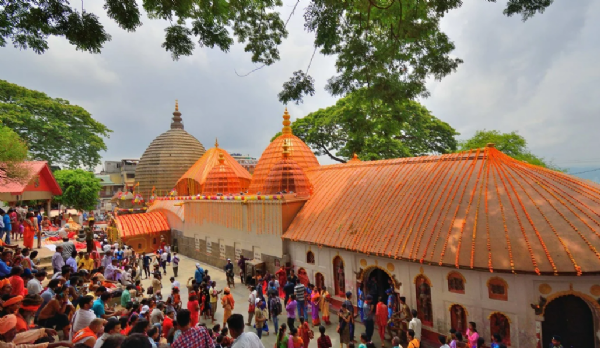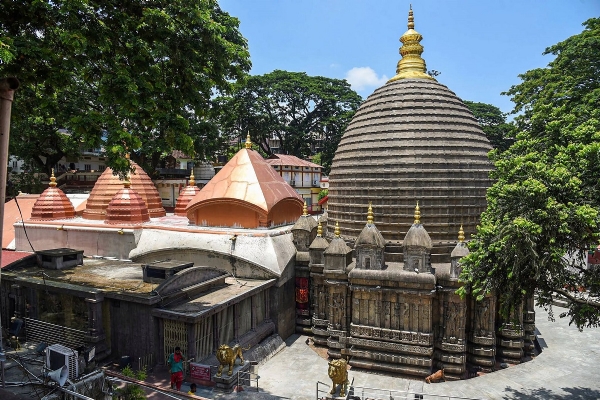The mysterious Kamakhya temple of Assam!
16 May 2022 17:30:52
This temple we will look at today is probably one of the most mysterious ones in the country, engulfed in legend and beliefs! On the Nilanchal hill in the western of Guwahati in Assam, lies the Kamakhya Temple - one of the most prominent shrines of Goddess Shakti in India. Hindu scriptures say that there are four important Shakti Peethas in the country - and Kamakhya Temple is one of them! Kamakhya Temple celebrates the power of the woman to give birth and is regarded auspicious amongst the followers of Tantrik sect of Hinduism. It was built and reconstructed several times between the 8-17th centuries.

Garbhagriha ia the main sanctum rests on a base which has a number of sunken panels embellished with the sculptures of Ganesha and other Hindu deities. It is situated below ground level and can be reached by a series of rock cut steps. The depression is filled with water from an underground spring and this is the general pattern of all the Garbhagrihas in this temple.

Natamandir - Towards the west of the Pancharatna is the last structure of Natamandir which has an apsidal end and ridged roof of the Ranghar type Ahom style. The walls of the Natamandir has inscriptions from Rajewas Singha and Gaurinath Singha inscribed upon them.

The entrance of the Kamakhya temple is beautifully designed with elegant carvings. The temple has a massive dome which overlooks the quaint Nilanchal Hills in the background. It is decked up the most during the Ambubachi Festival / fare that is held for a few days in the month of June.
History | The temple is one of the oldest temples in India, and hence has a long and renowned history associated with it. It is believed that this temple was built during the Mleccha dynasty in 8-9th century. The Kamarupa Kings right from Indra Pala to Dharma Pala were fervent followers of Tantrik cult, and at that time the temple turned into an important destination for Tantrikism. The Kalika Purana was composed in the 10th century and enhanced the importance of the temple as a place for Tantrik sacrifices and sorcery.
Mystic Buddhism started here during that time; several Buddhist professors in Tibet were known to belong to Kamakhya. Unfortunately, the temple was destroyed during Hussein Sha's invasion of the Kamata kingdom. The ruins remained undiscovered until 1500s when the founder of the Koch Dynasty Vishwasingha revived the temple as a worship site. The Kamakhya temple was reconstructed in 1565 during his son’s reign. Since then, the shrine has been an important religious centre for Hindus across the country.
Also Read | Shri Swaminarayan Mandir, the marbled beauty of Bhuj!
Architecture | The current structure of the Kamakhya temple is said to be of the Nilachal type, i.e. architectures with a hemispherical dome & a cruciform shaped base. The temple has 4 chambers aligned from east to west described as follows -
Garbhagriha ia the main sanctum rests on a base which has a number of sunken panels embellished with the sculptures of Ganesha and other Hindu deities. It is situated below ground level and can be reached by a series of rock cut steps. The depression is filled with water from an underground spring and this is the general pattern of all the Garbhagrihas in this temple.

The calanta lies towards west of the Kamakhya temple, and is a square shaped chamber of the atchala type. Small, moveable idols of Gods & Goddesses are found here, while walls of this chamber have several images & inscriptions carved onto its surface.
Natamandir - Towards the west of the Pancharatna is the last structure of Natamandir which has an apsidal end and ridged roof of the Ranghar type Ahom style. The walls of the Natamandir has inscriptions from Rajewas Singha and Gaurinath Singha inscribed upon them.
Legend | The Kamakhya Temple is a respected one for all Hinduism followers. Legend has it that during June, according to the Gregorian Calendar, the Bramhaputra River that flows beside the temple turns red! It is believed that this is a divine phenomenon and that it happens because the Goddess menstruates during this time. While some people claim it is due to the high iron and cinnabar deposits in the water, others continue to believe that it is a divine miracle! Thus, every year during the Ambubachi Mela, the river and the temple attracts thousands of devotees.
